#middle eastern folklore
Text

Léon Georges Jean-Baptiste Carré (1878 ~ 1942) 1926 illustration for 'The Book of One Thousand and One Nights'
#Léon Georges Jean-Baptiste Carré#Léon Carré#The Book of One Thousand and One Nights#Leon Carre#One Thousand and One Nights#Arabian Nights#1920s#Middle Eastern folktales#Middle Eastern fairy tales#folktales#fairy tales#fairytale#fantasy#folklore#fairy tale illustration#vintage art#vintage illustration
93 notes
·
View notes
Text

The Sultan orders to cut off Aladdin's head by Albert Robida
#aladdin#scimitar#art#albert robida#illustration#aladdin and the wonderful lamp#one thousand and one nights#1001 nights#arabian nights#folklore#folk tales#fairy tales#chains#sword#oriental#middle eastern#executioner#swords#folk tale#hanna diyab#china#chinese#the book of the one thousand and one nights#the arabian nights#antoine galland#mythology#asia#asian#sultan
45 notes
·
View notes
Text







Aesthetic for my Klaroline one-shot, Perhaps One Day - Chapter 12: Shifting Sands.
Klaus broke her heart years ago when he went off to play soldier — the last thing he expected was for Caroline to ask for his help rescuing her father.
#klaroline fanfic#uppitybitch fanfic#klaroline#klaroline aesthetic#aesthetic#klaroline does middle eastern folklore#ifrit
10 notes
·
View notes
Text
i need to draw dl characters in their traditional folk clothing
#mod.post#i need it so bad#love you ethnic traditions love you folklore love the proudness of one's heritage. do you get me#rahim and jade in folk turkish clothing... WITH CRANE. (<- headcanons him as middle eastern)
20 notes
·
View notes
Text
youtube
#hellhounds#monstrum#pbs#storied#english lore#folklore#european lore#asian lore#middle eastern lore#videos#Youtube
6 notes
·
View notes
Text
#skhemty#sunrise on the old kingdom#ambient#ancient egypt#egyptian#egyptian ambient#egyptian synth#fantasy synth#middle eastern#folklore#oriental#France#Bandcamp
3 notes
·
View notes
Text
How does one recognize the significance of storytelling in Middle Eastern art?
Storytelling has always held a central place in Middle Eastern culture, and its influence is evident in the art forms that have emerged from the region. Whether expressed through painting, sculpture, calligraphy, or other visual mediums, storytelling plays a vital role in Middle Eastern art, conveying cultural narratives, historical events, moral lessons, and personal experiences. In this…

View On WordPress
#artistic traditions#contemporary themes#cultural heritage#cultural identity#cultural narratives#cultural traditions#diversity#ethical values#folklore#heritage#historical and mythological narratives#historical events#Middle Eastern art#moral lessons#moral teachings#mythological narratives#personal experiences#personal narratives#power structures#Significance#social commentary#social issues#societal norms#storytelling#visual language#visual narration
1 note
·
View note
Text
The Golem and the Jinni by Helene Wecker
The Golem and the Jinni by Helene Wecker
Rating: 8/10
Recommended for:
Middle Eastern and Yiddish literature
19th century historical fiction
Adult fantasy with fable vibe
Read more or purchase on Amazon
Summary :
Chava is a golem, a creature made of clay, brought to life to by a disgraced rabbi who dabbles in dark Kabbalistic magic and dies at sea on the voyage from Poland. Chava is unmoored and adrift as the ship arrives in New…

View On WordPress
0 notes
Text
How To Write Vampires With An Original Twist
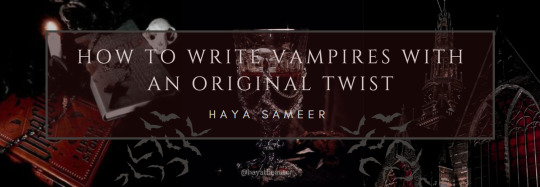
Mythical creatures are an essential part of the fictional scene, but the same creatures have been used so many times that these creatures now often seem redundant and boring in fiction. This is why I've started a new blog series: How To Create Original Mythical Creatures. I'm kicking off this series with vampires!
Join me as we dive into the world of vampires, from their mythical beginnings to their modern-day interpretations, and learn how to write them effectively in your own narratives.
Origins of Vampires
Vampires have a rich and diverse history rooted in ancient folklore and legends. Across various cultures and civilizations, tales of bloodsucking creatures have emerged, each with unique characteristics and behaviors.
One of the earliest known vampire myths comes from ancient Mesopotamia, where stories of blood-drinking demons known as Lilitu or Lamashtu date back to around 3000 BCE. These entities were believed to prey on humans, particularly targeting children and pregnant women.
In ancient Greece, the Lamia was a mythical creature often depicted as a female vampire who lured and devoured children. Similarly, in Roman mythology, the Strix or Strigoi were vampiric entities that fed on blood and flesh.
Moving forward in history, Slavic folklore introduced the concept of the Upyr, a vampire-like creature that rose from the dead to feed on the living. These early depictions of vampires often portrayed them as revenants or undead beings with a thirst for human blood.
Modern-Day Vampires: Where Were They Originated?
The modern concept of vampires, as we commonly know them today, took shape during the European Middle Ages and the Renaissance. Legends of vampires emerged in Eastern Europe, with notable figures like Vlad the Impaler contributing to the folklore. Vlad's reputation for cruelty and his association with impaling enemies on stakes led to the creation of the vampire archetype, inspiring Bram Stoker's iconic character, Count Dracula.
From ancient Mesopotamia to medieval Europe, vampire lore has evolved and adapted, weaving its way into popular culture and literature. Understanding the origins of vampires provides writers with a rich tapestry of mythology to draw upon when crafting their own bloodsucking creatures.
I wanted to go into more detail regarding the Lamashtu and Lamia since they’re not as well known as their Slavic and European counterparts, but unfortunately, that would deviate from the purpose of this blog.
The Evolution Of Vampiric Appearances
Before we proceed with this section, it's crucial to clarify that the mythical creatures and beings discussed in this blog are not direct representations of ancient vampires. Instead, they serve as inspirations for the concept of vampires and share certain attributes with our modern-day depictions, including blood-feeding, pale skin, human-like appearance with some animalistic features, and so on.
Vampiric Creatures In Mythology
In ancient mythology, vampiric entities were not always depicted as the suave, charming figures we see in modern vampire tales. Instead, they often embodied primal fears and monstrous traits.
Lamia: In Greek mythology, Lamia was a terrifying creature depicted as a woman with a serpentine lower body. She was known for her insatiable hunger for children, often depicted as a child-eating monster. Lamia's appearance combined elements of human and serpent, emphasizing her monstrous nature and predatory instincts.
Lamashtu: In Mesopotamian mythology, Lamashtu was a malevolent demon who preyed on pregnant women and newborns. She was depicted with a fearsome appearance, often described as having the head of a lion, the body of a donkey, and bird-like talons. Lamashtu's grotesque features and destructive tendencies reflected ancient beliefs about the dangers of childbirth and infancy.
Lilitu: In Mesopotamian and Jewish folklore, Lilitu or Lilith was often associated with nocturnal demons or spirits. She was depicted as a seductive, winged demoness who preyed on men and newborns. Lilitu's appearance varied across different myths but often included features like wings, long hair, and sometimes talons, emphasizing her otherworldly and dangerous nature.
Strix: In Roman and Greek mythology, the Strix was a bird-like creature or vampiric owl associated with dark omens and death. It was believed to be a shape-shifting creature that could transform into a woman or an owl. The Strix's appearance combined avian and human features, instilling fear and dread in those who encountered it.
Strigoi and Upyr: In Eastern European folklore, Strigoi and Upyr were blood-sucking undead creatures similar to modern-day vampires. Strigoi were believed to be restless spirits or revenants that returned from the dead to torment the living. Upyr, on the other hand, were vampire-like beings with sharp fangs and a penchant for drinking blood. Both creatures were depicted as pale, gaunt, and often with elongated canines, reflecting their predatory and undead nature.
Medieval Depictions: Shift in Appearance
During medieval times, the depiction of blood-sucking mythological creatures underwent a transformation, shifting from monstrous and terrifying to more humanoid and relatable appearances. This change in portrayal can be seen in various aspects of their physical features:
Teeth: Originally depicted with long, sharp fangs or talons for blood-drinking, medieval depictions often featured more subtle fang-like teeth or no visible teeth at all, aligning with the concept of vampires being able to blend in with humans.
Skin: While ancient vampires were often described as monstrous and otherworldly, medieval vampires were portrayed with paler skin to signify their undead nature but without extreme deformities or monstrous features.
Appearance: Medieval vampires were often depicted as more human-like in appearance, with regular clothing and a less monstrous demeanour. This shift allowed for more nuanced storytelling and exploration of themes like temptation, desire, and the struggle between humanity and monstrosity. This is also what birthed the romanticization of vampires.
Mythological Vampire vs Modern-Day Vampire
Mythological vampires, rooted in ancient folklore and mythology, were often depicted as malevolent spirits or creatures with supernatural powers. These creatures varied widely across different cultures, from the Lamia and Lilitu in Mesopotamian mythology to the Strix in Roman and Greek folklore, and the Upyr in Slavic tales.
These ancient vampires were not always the suave, charismatic beings we see in modern media. Instead, they were often portrayed as terrifying and monstrous, with features that reflected their otherworldly nature. For example, the Lamia was described as a demonic woman with the ability to transform into a serpent, while the Lilitu were associated with storm demons and fertility spirits.
In contrast, modern-day vampires, especially those popularized in literature and film, have undergone significant transformation. They are often depicted as sophisticated and alluring, with a penchant for romance and drama. Authors and filmmakers have humanized vampires, giving them complex personalities, tragic backstories, and even moral dilemmas.
While modern vampires still retain some traditional attributes such as a need for blood and sensitivity to sunlight, their portrayal has evolved to include a wide range of characteristics and abilities. This shift has allowed for more diverse and nuanced storytelling, exploring themes of immortality, love, redemption, and the eternal struggle between good and evil.
Which Option Is Better For Your Novel?
When deciding which type of vampire to incorporate into your story, consider the tone and themes you wish to explore. Mythological vampires offer a darker and more primal essence, rooted in ancient fears and superstitions. On the other hand, modern-day vampires provide a canvas for exploring human emotions, relationships, and societal issues through a supernatural lens.
Ultimately, the choice between mythological and modern vampires depends on the narrative direction and atmosphere you want to create. Both types offer unique storytelling opportunities, allowing you to craft captivating tales of mystery, romance, horror, or even philosophical introspection.
Research and Resources
Writing about mythical creatures like vampires requires a solid understanding of folklore, mythology, and literary traditions. Here are some resources and research methods to help you delve into the world of vampires and other mythical beings:
Books and Literature
Start by exploring classic works of literature that feature vampires, such as Bram Stoker's "Dracula," Anne Rice's "The Vampire Chronicles," and Stephenie Meyer's "Twilight" series. These novels not only showcase different interpretations of vampires but also delve into the cultural and historical contexts surrounding these creatures.
Mythology and Folklore
Dive into ancient myths and folklore from various cultures to uncover the origins of vampire legends. Look into Mesopotamian, Greek, Roman, Slavic, and other mythologies to discover different vampire-like entities and their characteristics.
Research Journals and Articles
Academic journals and articles can provide valuable insights into the evolution of vampire folklore, the psychological aspects of vampirism, and the cultural impact of vampire mythology. Explore journals in folklore studies, literary analysis, and cultural anthropology for in-depth information.
Online Resources
Utilize online platforms such as mythology databases, folklore websites, and literary forums to gather information and engage in discussions about vampires. Websites like The Vampire Library, Vampire Empire, and Vampire Rave offer a wealth of resources for vampire enthusiasts and writers.
Historical Research
Delve into historical records, archival documents, and historical accounts related to vampire hysteria, vampire burials, and vampire folklore in different regions. Understanding the historical context can add authenticity to your portrayal of vampires.
Interviews and Expert Opinions
Consider reaching out to folklore experts, historians, and scholars specializing in vampire mythology for interviews or consultations. Their insights and expertise can provide valuable perspectives on vampire lore and storytelling.
Creative Exploration
Don't hesitate to let your imagination roam while exploring vampire mythology. Experiment with creating your own vampire mythology, incorporating unique traits, powers, and origin stories for your vampires.
By combining thorough research with creative exploration, you can develop rich and compelling portrayals of vampires in your writing. Remember to stay open to diverse interpretations and adaptations of vampire folklore, allowing room for innovation and originality in your storytelling.
I hope this blog on How To Write Vampires With An Original Twist will help you in your writing journey. Be sure to comment any tips of your own to help your fellow authors prosper, and follow my blog for new blog updates every Monday and Thursday.
Looking For More Writing Tips And Tricks?
Are you an author looking for writing tips and tricks to better your manuscript? Or do you want to learn about how to get a literary agent, get published and properly market your book? Consider checking out the rest of Haya’s book blog where I post writing and publishing tips for authors every Monday and Thursday! And don’t forget to head over to my TikTok and Instagram profiles @hayatheauthor to learn more about my WIP and writing journey!
#hayatheauthor#writing community#haya sameer#haya's book blog#writing tools#writing advice#writer things#writer community#haya blogs#writers on tumblr#writing life#writing techniques#writing stuff#writer tools#writers of tumblr#writer blog#women writers#writer stuff#writer advice#writer tips#creative writing#novel writing#writing vampires#vampire#vampire books#writerblr#writing corner#writing inspo#ya writing advice#writing tips and tricks
126 notes
·
View notes
Text
Support Palestinian Musicians & Artists :
Here is a list of Palestinian musical artists, musical groups & bands, to make it easier for you to stop supporting musicians and artists who support genocide and occupation…
Faraj Sulieman : a solo musician who makes musical works that are very piano & jazz infused with a hint of rock n’ roll. He has performed in many countries in Europe and the Middle East. He has released 10 albums in the last 10 years, one of them being a children’s musical album called “Faheem” that found major success with the voices of the 2 kids, Faheem Abu Hilu and Hala Qassis, that were very dominant in the album alongside the sound of classical piano played by Faraj Sulieman himself. He also made the soundtrack for the Palestinian movie “200 meters” directed by Ameen Nayfeh. (Recommended Works : Better Than Berlin / Second Verse / Upright Piano)
DAM : a rap band founded in 1999 by the 2 brothers Tamer and Suhel Nafar along with their friend Mahmoud Jrere, the 3 rappers who came out of the city Lod [a mixed city that has indigenous Palestinian citizens & zionist Israeli settlers] make songs mostly about the inequality in the authorities’ treatment towards Palestinians, and songs criticizing the Palestinian society living in occupied territory under the Israeli Government… They primarily rap in Arabic, yet they sometimes use English & Hebrew as well. In recent years the female artist Maysa Daw has joined the band replacing Suhel Nafar and adding a feminine perspective to the band’s niche. It’s also important to mention that DAM was the first ever hip-hop band in the entirety of the Middle East. (Recommended Works : Ben Haana Wa Maana / i don’t have freedom)
Tamer Nafar : as mentioned before, he is a Palestinian rapper and actor and one of the founding members of DAM. Besides his works with DAM he also produces music under his own name, sometimes collaborating with various Palestinian & international artists. He also participated in making the soundtrack for the film ‘Junction 48’. (Recommended Works : The Beat Never Goes Off / Johnnie Mashi)
Maysa Daw : a solo musician, singer & songwriter, and as mentioned before the freshest and newest member of the band DAM, and a member of the newly formed female group called Kallemi, She was featured in Vogue Arabia 2019 as one of 5 Arab stars setting the world of art, culture and entertainment. She is also the daughter of the actor and director Salim Daw. (Recommended Works : Asli Barri / Between City Walls)
47SOUL : a group of four men who are all originally from Palestine that have created a new music genre called “Shamstep” which is an electronic dance movement mixed with the sound of Palestinian & Middle Eastern folklore. The musical group was formed back in 2013, and since then they’ve become pioneers in that unique style of theirs and have been on tours all over the world from the US to the UK and of course the Middle East. They’ve performed in NPR’s tiny desk in 2019 which helped them gain even more international recognition. (Recommended Works : Shamstep / Semitics / Shireen)
El far3i : he is a Palestinian-Jordanian rapper, singer, songwriter, and percussionist. He is currently a member of the Shamstep band 47Soul, and was formerly a member of the Arabic rock band El Morabba3. He started his career in 2012, and has since released six solo albums. (Recommended Works : Tghayarti)
Shabjdeed : Straight out of the restless town of Kufr Aqab, Palestine, emerged a talent by the name of Abu Othaina. With his controversial takes and raw skills Shabjdeed was an instant addition to the Palestinian rap scene. After gaining traction from his self-titled track, he caught the attention of Al Nather, a local producer, and worked with him to create the alter-ego Shabjdeed; an act that can easily be considered one of the most influential and popular in the region. The duo developed their own niche dark hip-hop and trap style combining Shabjdeed’s nihilistic and daringly personal delivery style with Al Nather’s colourful and rhythmic instrumentals. From the beginning they have been able to build a dedicated fanbase, grossing over 1.5 million total streams on Soundcloud across two years whilst only relying on word-of-mouth advertisement. The duo have created together a record label and named it BLTNM Records which was brought to it’s biggest success with the release of Shabjdeed’s first full length album called “Sindibad el Ward”. And today Shabjdeed’s music is the modern voice for not only the Palestinian revolution, yet for the entire revolution in the Middle East caused by youth that dream of a better future and go against their capitalist and money hungry governments. (Recommended Works : Fi Harb / Aadi / inn ann / Ko7ol w 3atme)
Daboor : A Jerusalemite rapper to the bone, Daboor’s debut single “Liter Black'' was released in 2020 to much fanfare and critical acclaim. His unique style and raw talent cemented his status in the rap scene and he was soon signed to BLTNM Records. Daboor’s words touch on the violence of the occupation, and his delivery mimics it with brutal bursts of staccato. (Recommended Works : Inn Ann / Dolab)
Lina Makhoul : an independent American-born Palestinian singer-songwriter & producer. She was raised in the city of Acre in occupied Palestine since the age of 4 and according to her she has showed interest in music and dance since a young age. She started her career in 2012 and has since released 1 full length album as well as a number of hit singles, She also opened for Queen+ Adam Lambert in 2016 and toured with Little Mix in 2017. (Recommended Works : Shway Shway / Fish Masari / 3 sneen)
Elyanna : a Palestinian-Chilean singer-songwriter who started her career in 2018 and has since released 1 full length album and a number of singles, and she has collaborated with artists with significant recognition such as Massari. She performed in Coachella 2023 to become the 1st ever Middle Eastern & Palestinian artist to perform in Coachella in Arabic. (Recommended Works : Ana Lahale / Ghareeb Alay)
Noel Kharman : She is best known for doing mashup covers where she mixes Middle Eastern and Western music, creating a unique bridge between these two worlds through her powerful and angelic voice. She started her career on Youtube with covers of viral songs, but her big breakthrough happened in 2015 when she published her first mash-up cover which was a mix of ‘Hello’ by Adele with Fairuz. The cover went viral overnight and since then, she became an instant internet sensation. The cover has gained over 30 million views on YouTube. Today she has released many songs of her own after being signed to a record label and has collaborated with various artists and went on tour in many cities in the Middle Eastern region. (Recommended Works : Ya Lali)
The Synaptik : This Palestinian-Jordanian artist based in Palestine started making music at the age of 17. The Synaptik studied medicine for 7 years and graduated. His stage name is derived from his fascination with the nervous system, neurotransmitters and his personal experience with ADHD, which led to calling himself The Synaptik: “…because that’s where things happen.” The Synaptik has pioneered a new wave of sound for the Arab youth. His honest and potent lyrics are highlighted by his songwriting style that merges singing and rapping effortlessly. With a tsunami of a first album under his belt, dozens of local, regional, and international shows and a much-anticipated second album, The Synaptik has cemented his status as one of the pillars in the Hip Hop scene in the region. The Synaptik has collaborated with numerous artists from all over the Middle East such as rap superstars Abyusif, Wegz, Marwan Mousa, Chyno with a Why?, Shabjdeed and more. (Recommended Works : Sabelek)
Apo & The Apostles : Apo & the Apostles started out late 2013 in Jerusalem-Bethlehem with their first release in March 2014. Since then, they've been taking their music to whoever and wherever they are welcomed. The band is known for their energetic performances that turn to parties and after-parties. (Recommended Works : Baji Wenek)
#palestine#palestinian art#palestinian artists#palestinian music#music#i stand with palestine 🇵🇸#free palestine 🇵🇸#stop palestinian genocide#palestinian lives matter#from the river to the sea palestine will be free#save palestine#palestina#filistin#from the river to the sea 🇵🇸#filistin 🇵🇸#فلسطين 🇵🇸#free gaza#gaza#gaza strip#gazaunderattack#gazaunderfire#save gaza#free palestine#free free palestine#end the genocide#end the occupation#end the war#end the siege#end the apartheid#gaza under attack
192 notes
·
View notes
Text
On Reading and Books
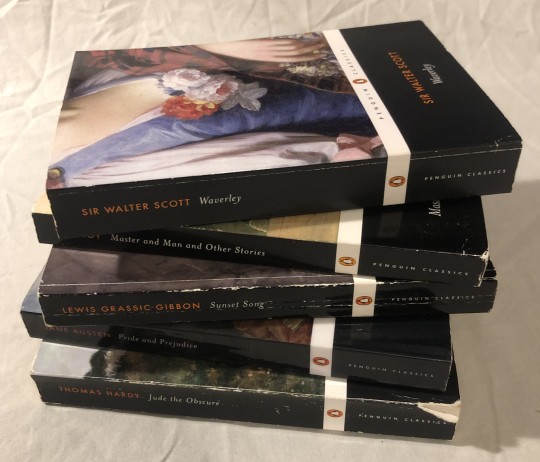

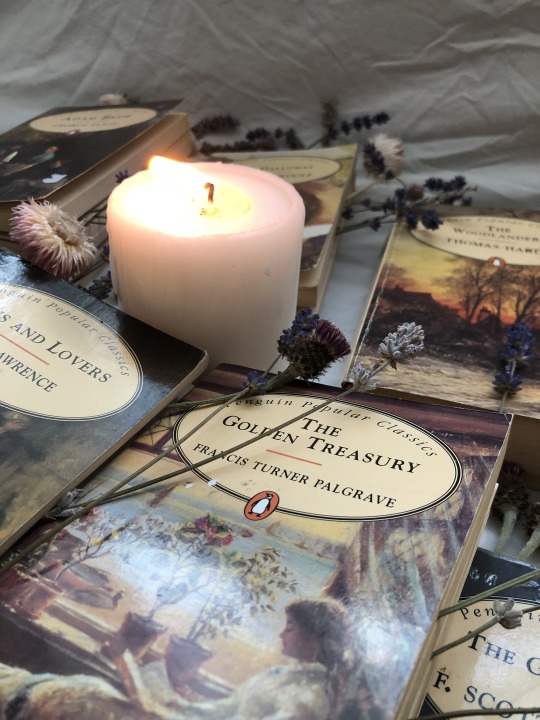
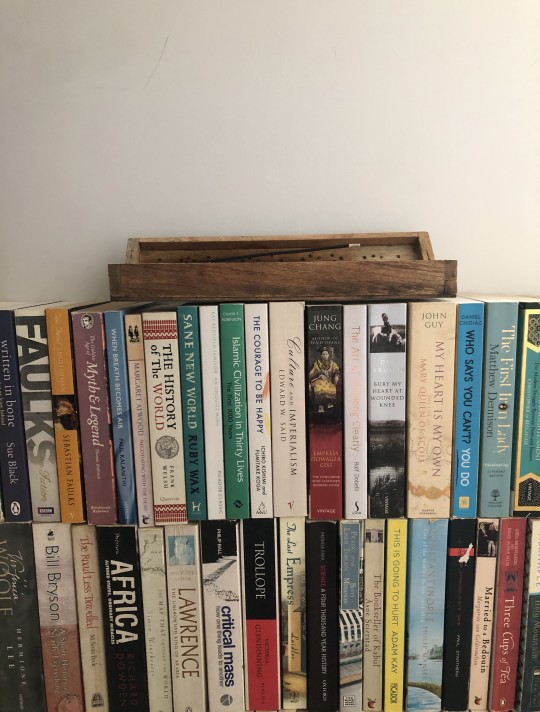
I took these pictures myself. Some of these books are old, some were just poorly handled over the years, and all were thrifted across the second-hand stores of Dublin.
Here I link every post I make on quotes, musings, and letter extracts from authors to do with books and reading. I keep it up to date.
I own books of all genres, so from fiction, you can expect: high fantasy, urban fantasy, classic literature, modern classics, short story anthologies, poetry, translated fiction, Asian fiction, Middle Eastern fiction, North African fiction, African fiction, Western fiction, Irish fiction, myth and folklore retelling, historical fiction, murder mysteries/crime fiction.
And from non-fiction, you can expect: European history, African history, Irish history, Asian history, Middle Eastern history, Islamic history, biographies and memoirs (of classic authors, world travellers, queens, and empresses), science, female health, culture and anthropology, self-help, psychology, on writing, on reading, myth and folklore, travel memoirs.
As such you can expect quotes from authors of various backgrounds.
These are short posts, made up of the extract ill quote from the author and then a picture I've taken of books from my home library.
Marcel Proust.
J. R. R. Tolkien.
Donna Tartt.
Franz Kafka.
Vladimir Nabokov.
William Faulkner.
Ian McEwan.
Italo Calvino.
Virginia Woolf.
Smell of Books.
Cats n Books
Charles Dickens.
Jules Verne.
About Me
Bookblr Masterlist
Bookish Thrift Finds Masterlist
I reblog bookish content and since I have a home library I also make bookish content myself; aesthetic book pics, reviews, recommendations, quotes, excerpts, hauls and cats.
#books#book quotes#chaotic academia#dark academia#light academia#reading#literature#fiction#nonfiction#home library#library#book rec#book recommendations#classic books#modern classics#thrifted books#middle east#north africa#irish#quotes#author quotes#classic authors#academia#lit#on reading#NEJJ QUOTES
61 notes
·
View notes
Note
Could you do tfp predaking tfp optimus and tfp megatron meeting an eastern dragon s/o that's been asleep in a lake for thousands of years gaurding an ancient/powerful cybertronion relic? (I just want to see their reactions to meeting an actual dragon, good day.)
I did it so they're meeting the reader for the first time, so it's not romantic. I didn’t do Optimus, because I couldn’t come up with enough stuff. I kinda changed some of the stuff for the Predaking one, but I hope you still like it
~Megatron~
•When Soundwave was decrypting the Iacon files (or whatever they were called) he found a mention of a powerful relic, that was hidden somewhere in the east
•The coordinates lead Soundwave to somewhere in rural Japan, and Megatron decided to go find it himself
•He was getting bored, since he hadn’t left the Nemesis for a while and he wanted something to do
•So he took the ground bridge near the location of the relic and found himself near a big lake
•Megatron doesn’t exactly enjoy getting wet, so he wasn’t really thrilled about the idea of diving into the lake
•Turns out he didn’t need to though, because the second he touched the water, there was a tremor and he could see something rising to the surface of the water
•Something big came out of the water and of course Megatron aimed his blaster at it, but for some reason he didn’t start firing like he usually would
•The thing that came out of the water lowered itself back to the surface of the water, like it was standing on it
•You sensed something familiar and were stirred from your slumber, when you felt the presence come closer and touch the water
•When you broke the surface of the water, you saw something familiar standing on the shore
•You landed on the surface of the water and looked as the mech standing in front of you
•”And which faction might you be with?” you asked
•Megatron was very surprised that this giant creature in front of him could speak, but he answered your question anyway
•”You’ve come for the relic I assume?”
•”You know of it?” Megatron asked, finally lowering his blaster
•”Yes, of course. It is my job to guard it” you tell him
•Megatron considered his choices for a moment, he could fight you and take the relic by force, or he could hear you out
•Opposed to what he might usually do, he decided to talk to you instead of just punching you, because there was something about you that was making him a bit hesitant about getting in a fight with you
•”I’m here to take the relic back to where it belongs” Megatron said, trying not to escalate the situation, while still sounding very commanding
•”No” you just said, before swiping him with your tail and sending him flying into the woods
•When Megatron marched back to the beach, you had disappeared back into the depths of the lake
•Megatron is not familiar with human folklore or myths, so he has no idea what you were, he just thought you were some sort of animal
•When he described you to Soundwave though, he showed Megatron a few pictures of eastern dragons and the pictures were pretty spot on
•Obviously he’s not going to give up on the relic, he’s not opposed to getting you out of the way by any means necessary, but he also has a feeling you’re not going to be an easy opponent
~Predaking~
•Predaking had left the decepticons to travel and to see the world
•One night he landed in the middle of the woods on a mountain side, because the trees had caught his attention and he felt like something was drawing him there
•He had landed in a grove of beautiful trees with purple flowers, he later learned they were wisteria trees
•He decided to rest there, but soon after he settled down to recharge he saw the air in front of him vibrate and move
•It was like you just materialized in front of him, a big, snake like, dark blue and gray creature
•Predaking got back to his feet and took a few steps back in surprise
•You didn’t seem hostile or malicious, but Predaking was so surprised by your sudden appearance
•”I thought I sensed one of your kind, but you seem different than the ones before you” you said as you stretched a bit
•You didn’t know how long you’d been sleeping, but it had clearly been quite a long time
•You’d sensed a cybertronian closeby so you came out of your little pocket dimension where you’d been sleeping
•Predaking obviously had no idea what you were, the only thing he was sure of was that you weren’t a human
•”What are you?” he asked
•”I have many names but the one you might be most familiar with is “a dragon”” you told him
•Predaking was in awe, your scales were shimmering in the moonlight and you exuded this sort of graceful and majestic air, that he hadn’t really felt before
•Predaking was also a bit confused by what you meant by the “ones before you” comment so he asked you about it
•”You’re not the first cybertronian I’ve met, young one” you said. “Why have you come?”
•”I just happened to stop here”
•You were a bit surprised by his answer, since you thought someone had finally come to get the object that had been left in your care, but since it seemed that was not the case, you decided not to mention it
•You found yourself interested in this odd cybertronian that had found his way to your grove
•You let Predaking rest there, but you kept an eye on him while he recharged, making sure he didn’t accidentally burn down the wisteria grove you called home
#transformers#tfp#transformers prime#decepticons#megatron#predaking#tfp headcanons#reader insert#platonic transformers x reader
154 notes
·
View notes
Text
Resources for Cuban and Caribbean Folk Magic 🇨🇺
Disclaimer: Cubans are not a monolith so when we say ‘Cuban Folk Magic’ its like saying ‘American Folk Magic’ in the sense that it is a BROAD term that includes multiple different cultural threads and traditions. Start by researching your ancestors and where they were from as a jumping off point.
Also, many of these resources are not Cuban themselves, but they either share the same practices or are academic or general sources. I have made it clear when a source isn’t Cuban. For this reason, I have expanded it to be the Cuban AND Caribbean Folk Magic List.
The List
General:
Irka Mateo - Taino - Insta 🇩🇴
Religion.Ancestral.Taino - Insta 🇵🇷
Sancista Brujo Luis - Espiritismo/Taino-Youtube | Blog 🇵🇷
OkaniLuna - Brujería/Taino - Youtube🇩🇴
Juliet Diaz - Brujería/Taino/Author - Instagram 🇨🇺
Sancista 7 Espadas - Espiritismo - Insta 🇵🇷
Odofemi - Regla de Ocha - Tumblr 🇺🇸
Eve the Medium - ATR/Espiritismo - Youtube 🇩🇴
Yeyeo Botanica - ATR/Espiritismo- youtube 🇺🇸
Botanica Candles & More - Great Podcast!! - youtube 🇨🇺 🇺🇸
Connecting w/ Guides and Goals by Adunola - youtube 🇺🇸
San Lazaro - Wikipedia - Novena - Yeyeo Botanica
Caridad del Cobre - Wikipedia
Orisha and Palo Herbs Directory- Website
Ewe (Herbs) Photo Guide - Website
Pueblo Originario Taino Section - Website
Books:
Taino Library* - Amazing resource for books of all kinds, many books about Taino, Cuban and Caribbean Spiritualities, Folklores and Songs! Multiple books on Cuban Myths and Folktales! Highly recommend - Website 🇵🇷
Espiritismo by Hector Silva🇩🇴
A Year in White by C Lynn Carr
The Modern Art of Brujería by Lou Florez(VERY BASIC just as a general introduction to what alot of modern Folk Practices look like)
American Brujeria by J. Allen Cross 🇲🇽🇺🇸
El Monte by Lydia Carbera 🇨🇺
Movies:
Cecilia (1982) - Youtube
Las Profecias de Amanda - Youtube
This list will grow as I find more resources that are reliable enough to share. If you have recommendations or would like to be added, please reach out.
Luz y Progreso 🕯️
(I also have included a Research Guide below the Cut!)
Guide to researching based on your ancestry:
If your family has African roots, you can seek Ocha/Lukumi, Palo, Arara, Cuban Vodou and other African Traditional Religions and Practices. Please approach elders within these respective practices to further your connection to them, rather than using books to create a practice for yourself. These are ancient, community based and are lifelong commitments, not just trendy powerful spells for you to get what you want.
If your family has indigenous roots, research Taino spirituality and modern practices , but also know that there were other tribes in the western and centeral parts of Cuba, with their own languages and traditions you can still learn about like the Guanahatabey. You may also consider joining a Yukayeke, but this isn’t required. Reconnecting and decolonizing is a separate and important topic that is not inherently witchcraft or folk magick-y… HOWEVER, researching and informing yourself with these practices can help you to see their influence within modern folk practices.
If your family has Asian roots, research the buddhist cults and folk practices throughout Cuba! Believe it or not, we also have people of Middle Eastern descent in Cuba who brought with them their own Hindu and Arabic Folk Traditions, which can be found throughout Cuba and the Caribbean as a whole.
If your family has Spanish roots, research some open practices like Espiritismo and Folk Catholicism! Look into the Patron Saints of Cuba, La Virgen de La Caridad del Cobre and San Lazaro. These also tie in to many of the other cultures who were forced to adopt certain elements to ensure survival of their traditions! You can also look into Brujería. Much like modern witchcraft, modern brujería has been commodified to hell and back, but there is still some great knowledge and power to be found there.
The fact of the matter is, that most of us can fit ourselves into two or more of these categories, and this crossover is where Folk Magic is often born. Its also important to note, in alot of these traditions you shouldn’t learn or share certain things at certain times, so some sources who share too much about Ocha and other ATRs should be avoided. Also, I can’t stress how important it is to talk to your family! Ask them about folklore or legends and stories! Also research history and folkore of the specific areas in Cuba your family is from. A-lot of folk magic is incorporated into stories.
Bendiciones, good luck on your Journey!🦎🐊

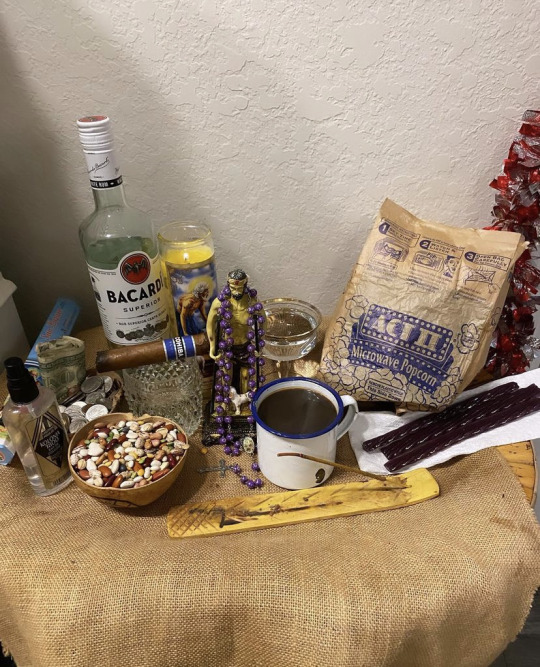
35 notes
·
View notes
Text
Kizazi Moto review
Kizazi Moto: Generation Fire is an anthology of animated shorts from studios all over Africa, with the theme of afrofuturism and science fantasy (mixing frequently indigenous spiritual beliefs with the tech, and many shorts are actually about gods or spiritual beings). It's a shame that the project is attached to Disney, because this is one of the best anthologies I've seen in a long while.
So let's review the individual shorts.
Herderboy
By Uganda's Raymond Malinga, this portrays the story of a boy trying to join a band of herders, which harvest kyber crystals from cyborg cows and are under constant attack by spirits (read dark side hyenas). It's a good start to the anthology; the CGI is bright and makes good use of color, and it has a nice twist at the end.
7/10
Mkhuzi the Spirit Racer
By South Africa's Simangaliso Sibaya and Malcolm Wopé, this one bears a bright and joyous 2D animation. It features a half-human half-something boy who struggles with his Zulu identity, and that all comes crashing down in a race against gentrification. It's a delightful short with beautiful visuals and actual incorporation of cultural themes into the narrative.
9/10
Moremi
By Nigeria’s Shofela Coker, this is a pretty bleak looking CGI short not out of place in Love, Death & Robots. Long ago, soul stealing giants forced a woman to construct magical machines by giving her son's heart to the gods; this is about the summary you're gonna get without getting into heavy spoilers. A delight if you're into mythology as there's quite a few allusions to Nigeria's folklore, but I can see people getting a bit confused and the visuals can be grating at times.
6/10
Surf Sagoma
By South Africa’s Nthato Mokgata and Catherine Green, in a future where sea levels rose and mutant octopi lurk in the depths a boy is peer pressured into surfing in dangerous waters. I have to say, while this has a happy ending it is rather bleak and the CGI visuals are not particularly pleasing.
5/10
First Totem Problems
By South Africa’s Tshepo Moche, we're back to 2D, this time more Disney-esque. If I had to describe this, it'd be like a mixture of the first half of Brother Bear and Coco. It's pretty fun, though a bit lacking in substance and the family feuds can get grating.
7/10
Mukudzei
By Zimbabwe’s Pious Nyenyewa and Tafadzwa Hove, an influencer desecrates Great Zimbabwe, only to be taken to a timeline where it never fell to colonialism and became basically Wakanda. The concept alone is amazing, though the story itself is rather generic.
8/10
Hatima
By South Africa’s Terence Maluleke and Isaac Mogajane, this is by far my favourite of the shorts, it features the tragic conflict between merfolk and humans, with a Black Panther 2 reveal at the end. With stellar 2D animation and allusions to Dogon mythology, as well as a good solid plot where the reveal has just the right amount of foreshadowing without becoming obvious.
10/10
Stardust
By Egypt's Ahmed Teilab, I had the highest expectations for this one, being the only Middle Eastern short in the mix. It's an alright story, I really loved the science fantasy twist on astrology by just being handed a "destiny" in a tube with stars inside. The protagonist naturally choses her own fate over the manufactured ones... though getting there is quite spoilerific.
8/10
You Give My Heart
By South Africa’s Lesego Vorster, this is another return to 2D animation and the second one about influencers amusingly enough. The plot kicks off in a competition in which the human contestants can ascend to godhood. Godhood is very much treated like being an influencer, and amusingly one of the previous contestants was demoted by typing in all caps. Overall pretty fun and the animation is gorgeous, though the characters designs can get a bit ugly.
9/10
Enkai
By Kenya’s Ng’endo Mukii, the final short is done in a CGI mimicking stop motion, which combined with the stellar coloration and lighting makes for a stunning visual experience. This too deals with the divine, this time the young Enkai seeking to become a creator deity like her mother. There is a big plot twist that I will not spoil, and recontextualises the whole short.
9/10
Conclusion
I give the overall anthology 9/10; barring a few hiccups, these are wonderful stories from Africa's many creative voices. Again, pity Disney has a grasp on this.
80 notes
·
View notes
Text
Writeblr Intro

Hi! My name is Sam (they/them), and I write SFF.
About me:
I'm queer, in my late 20s, and I live in Europe.
Pets? Two cats + 1 orange braincell
Favourite food? Please don't make me choose.
What I write? Hard fantasy with excessive worldbuilding
Favourite books? The Silmarillion by JRR Tolkien. The Stormlight Archive by Brandon Sanderson. The Traitor by Seth Dickinson. Red Rising by Pierce Brown. Uprooted by Naomi Novik.
Fiction I probably won't enjoy? Romance. Middle grade. Most High School YA. It's just not my cup of tea.
Outside of writing? I'm a mathematician-turned-programmer who wishes they've gone into a more creative career
Silmarillion blog: @ward-of-irmo
Personal blog: @careening-mind
Read all the snippets I've posted under this tag.
DMs/Asks/Tag games? Yes, please
This blog is a mix of things related to my writing, from snippets, through info dumps, to historical trivia and inspirations for the setting. Also, cats.
I'm happy to do beta swaps.
About my writing:
Expect themes of found family, battling inner demons, finding one's identity and strength. But also, superpowered sword fights and epic locations. Don't expect romance front and centre, and don't expect characters who are minors. Most of my characters are openly queer; I enjoy seeing people I can identify with partake in fantasy adventures, without their identities being a burden.
I write multi-POV stories, 3rd person only. I'm not that keen on seemingly unrelated POVs coming together, but I love seeing group interactions through the eyes of a different person each time.
I like turning 'what if' questions into stories - what if the Chosen One was chosen by the villain? What if a Bronze Age civilisation experienced a first contact with an alien race? What would crime-scene investigation look like in a setting where people turn to dust upon death? I also love learning, and I learn by researching random areas that are tangentially related to my writing projects.
Are my fantasy settings too realistic? Maybe. Am I having fun writing it? Definitely.
About my WIPS:
The Sunblessed Realm
Hard fantasy, queernorm setting inspired by Slavic folklore and the history of Central-Eastern Europe. The age of heroes has passed. The heroes remain alive.
A list of all stories and longer snippets in this setting that I've posted.
Days of Dusk trilogy [Tag]
Swords used to be the protectors of the world, channelling the power of the Elements to fight against the Primeval Darkness. Now that the threat is contained, they are perceived as a danger themselves. Their powers are feared, while any advantages they can give are made up for with developments in science.
Info dump posts: Map || Magic system || Fashion || Architecture || Cast
⚔️Gifts of Fate ⚔️
Intro post || [Tag]
The Witcher x Fullmetal Alchemist
Genre: NA hard fantasy
Pitch: The hero was chosen by the villain to become might incarnate. With all due respect, he'd like to decline.
Expect gratuitous superpowered HEMA fight scenes mixed with fridge horror.
Progress: First Draft done at 107k, beta readers' feedback received
⚔️The Prince's Shadow⚔️
Intro post || [Tag]
NA military fantasy.
The hero of the first instalment was deemed to dangerous to live or be killed. The Army's spymaster and the Chief Strategist set him up to die a hero's death.
Note: This was the first story I've written in this setting, with the pitch being 'the hero has just saved the world and needs to figure out what to do with his life'. It has evolved a fair bit since then.
Progress: Needs rewriting, now that the prequel is written.
⚔️Prodigal Children⚔️
[Tag]
Political fantasy.
The last - the only - war fought by Swords took place two millennia ago, and the memory of its horrors kept the princes motivated to stop it from happening ever again. When an uprising in one of the princedoms spills over the borders, it again becomes a real threat.
Now with more intrigue and sapphic romance.
Progress: First Draft done at 128k
To do: I've got feedback to incorporate
The Truth Teller [Tag]
Intro post
Urban fantasy version of the Eastern Bloc.
Three thousand years later, the heroes of the previous stories have passed into legends. There are no more Swords to protect, Crystals to heal, or Elemental Dancers to mend and build. There are only Knacked, shunned by the society.
Progress: Outline done, writing started.
Other
The Fulcrum
First Contact Sci-Fi from the point of view of the alien species. While their civilisation is comparable to early Iron Age ones on Earth, don't worry, they have nukes.
Progress: First Draft - 24k/100k
To do: more research
129 notes
·
View notes
Text


I love how unique Mushishi's soundtrack is, and I love folk and trad songs: voilà ✨
(songs info if you're interested:)
Anakrousis and Hymne au Soleil are from the same 1979 album "Musique de la Grèce Antique" (Music from ancient Greece), by the Spanish ensemble Atrium Musicae de Madrid. They specialised in playing pieces from medieval (or older) time periods. For this specific album they used actual music gathered from ancient papyrus and reconstructed ancient instruments to be as accurate as possible. I highly recommend the whole album, it's haunting.
Зора се е, мале, зазорила (translated as "Daybreak Dawned") is a song from Bulgarian folklore, sung here by the well-known Eva Quartet. (the music and lyrics here are probably an arrangement from a pre-existing folk song but I'm not 100% sure)
木曽節 (Kiso Bushi, literally Kiso's song) is a Japanese folk song from the Kiso district, and as its name indicates, it's a song celebrating the place it originated from. The song flows as does the Kiso river, and it's performed here by the Research Institute for Japanese traditional music (pretty self-explanatory).
Каа-Хем (Yenisei river) is technically not a folk song but Yat-Kha is a Tuvan band that relies heavily on tuvan folk sound (such as khöömei/tuvan throat singing) mixed with punk/rock/metal influences and it's very cool!! And this song is of course celebrating the Yenisei river and its beautiful landscape.
La rivière Tanier is a créole lullaby, lamenting the hardship of life as an old woman fishes in the river. Graeme Allwright created this particular arrangement ; he was a French New-Zealander who spent his life travelling and making folk music. He did a lot of different things throughout both his life and his music career, so I guarantee that you'll find something you'll like if you check out his stuff. Also!! he was bestie with Leonard Cohen!
نامي نامي (Nami Nami or Sleep Sleep) is a traditional lullaby from the Middle-East (probably Egypt ?) in which a mother comforts her child with promises of their father's return. It's performed here by the ODO Ensemble ; they're based in France but their goal is to collect and perform ancient music from all over the world.
The Passing of the Elves: yes it's a soundtrack from The Lord of the Rings so I'm stretching the meaning of "folk" a little bit, but Howard Shore drew heavily from Celtic and Eastern aesthetics and tones when composing the different leitmotivs for the Elves and I like how it sounds :) plus they used the actual Sindarin poem so that's cool!
五木の子守唄 (Itsuki no Komoriuta or Itsuki Lullaby) is, to everyone's surprise, a traditional Japanese lullaby from the Itsuki district! The original lyrics are bit grim (a babysitter exhausted by a crying child) , but this is a beautiful instrumental version arranged by Takasue Shibata, and I thought it made for a nice conclusion to this little journey ☀️🌙💧
#mushishiweek2023#mushishi week#Mushishi#i don't have spotify so youtube playlist it is sorryyy :(((#still not sure about the geeky track but oh well#balkan folk songs fuck SEVERELY they have all the best stuff i swear#although this was solely started by anakrousis because it has been living in my head rent free for literal years#bibi
45 notes
·
View notes